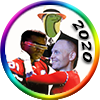We all bitch and moan about Greedo shooting first in the Special Edition of Star Wars, but George Lucas was far from the first guy to be revisionist with his own work. JRR Tolkien went back and changed a whole chapter in The Hobbit to make it better line up with The Lord of the Rings.
The original version of Riddles in the Dark, the chapter where Bilbo meets Gollum and gets the One Ring, was markedly different in 1937, when the book was first published. In that version Gollum is much less menacing, and the prize in the game of riddles isn't Bilbo's survival but rather the ring itself. In the original version of The Hobbit Gollum is quite happy to give away the ring, and when he loses the game he's rather bummed that he can't give it to Bilbo because he's lost it (Bilbo has already found it).
When Tolkien began work on a sequel (called The New Hobbit, after his publisher had roundly rejected material that would later become The Silmarillion), he changed the nature of the ring. Now it was a corrupting power, an insidious influence, and the idea that Gollum would happily give it up didn't fit. Tolkien needed to retcon his book, and he rewrote the chapter, sending it to his publisher in hopes of getting some help in fixing the discrepencies. In this version Gollum is a thrall to the ring, and he is a vicious monster who will kill to keep it. In the original chapter Gollum leads Bilbo out of the bowels of the mountain; in the revised chapter the creature chases Bilbo out.
Tolkien's publisher, Stanley Unwin, never got back to him, so Tolkien simply addressed the issue in the text of The Lord of the Rings. Since The Hobbit was presented as Bilbo's diary, translated by Professor Tolkien, he had Bilbo, during the Council of Elrond, explain he had lied about the circumstances of acquiring the ring. This establishes the power of the ring quite nicely. But Tolkien was surprised to find, in a galley of a new edition of The Hobbit, his revised Riddles in the Dark. Unwin had included it without telling him.
Tolkien made some other minor changes to the text of The Hobbit, many of which changed travel times so that distances in The Hobbit and Lord of the Rings matched. He changed some of the foods eaten, and most amusingly he changed the name of the High Elves. In the original text, the High Elves were called 'gnomes' after gnosis, the Greek word for knowledge. It soon became clear to Tolkien that the word gnome had a very different fantasy connotation to just about everybody else in the world.
One bit of retcon that never made it to publication during Tolkien's lifetime was The Quest of Erebor, which explained just why the hell Gandalf cared about Smaug so much anyway. By the time Lord of the Rings was finished, Tolkien had refashioned Gandalf, the wandering wizard, into an ancient being of immense power. The idea that he just idly set off on quests with troops of goofs was weird. The Quest of Erebor, a short story told from Frodo's point of view, was intended for the Appendices of Lord of the Rings and explained how Gandalf feared Smaug would be a tool for the newly rising Sauron. This information makes its way into The Hobbit: There and Back Again.
After Lord of the Rings Tolkien decided to revise The Hobbit one more time. This time around he intended to change the whole thing, to bring the narrative and tone more in line with the darkness of Lord of the Rings. He made it a few chapters in before everybody sensibly stopped him and told him he was ruining the original work. Those chapters have been published in a massive two volume set called The History of the Hobbit.
Tolkien's retconning makes him a harbinger for the modern age of nerd properties, where reboots and retcons are commonplace. They happen almost yearly in comics. In a lot of ways the expansion of The Hobbit into Lord of the Rings is also a harbinger for the modern age, as Tolkien took a children's story and turned it into something much grimmer and much grittier. But even still, he wasn't able to go all the way and change The Hobbit itself; in this day and age the idea of 'aging up' The Hobbit seems absolutely obvious, and completely like something a studio executive would demand. So while Tolkien was ahead of the nerd curve, he was only willing to go so far.








